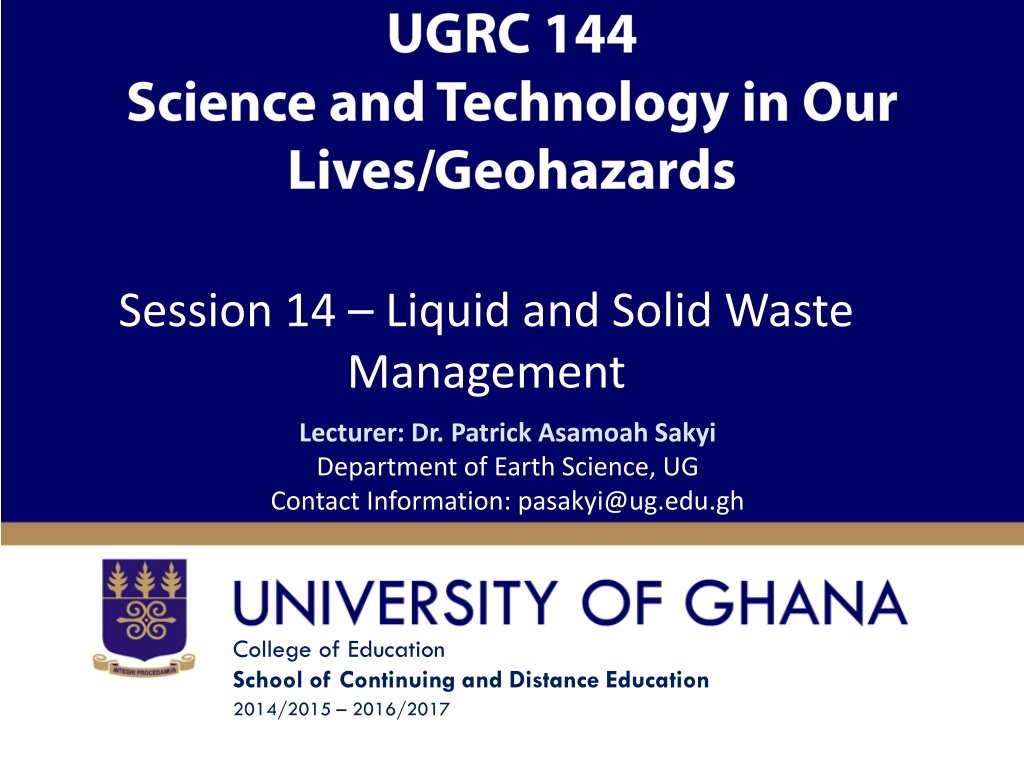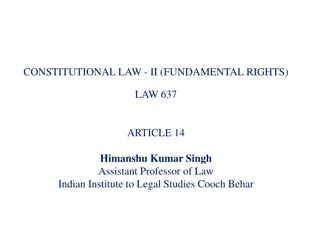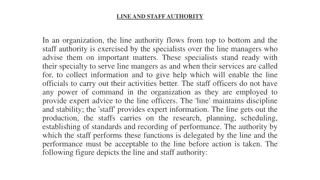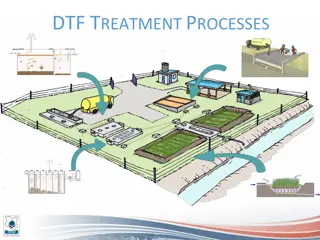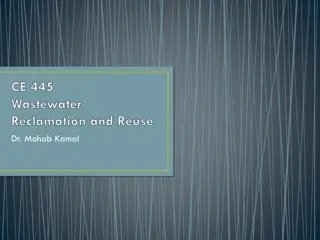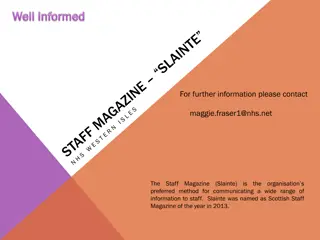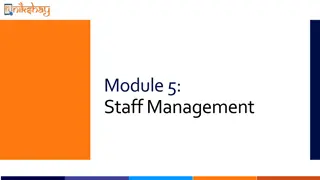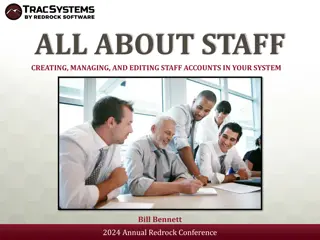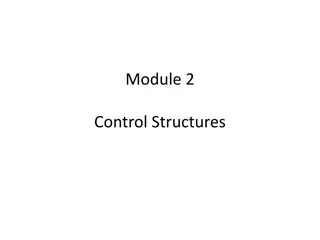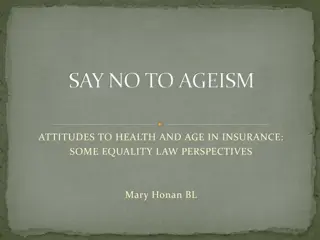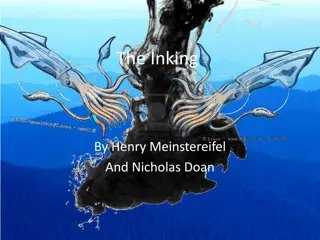Ensuring Equal Treatment for Staff and Students
Affirmative action is essential for promoting equal opportunities and fair treatment for all staff and students. It focuses on preventing discrimination and providing a level playing field for everyone to reach their full potential. This commitment to fairness is reflected in the school's policies, training programs, and grievance procedures. Additionally, federal and state laws like Title IX and Title VI further mandate the prohibition of discrimination based on various factors such as sex, race, and more. The school's affirmative action representatives oversee compliance with these laws, investigate grievances, and maintain necessary records to ensure a supportive and inclusive environment. Sexual harassment, a form of discrimination, is also addressed, highlighting the importance of maintaining a respectful and harassment-free atmosphere within the school community.
Download Presentation

Please find below an Image/Link to download the presentation.
The content on the website is provided AS IS for your information and personal use only. It may not be sold, licensed, or shared on other websites without obtaining consent from the author. Download presentation by click this link. If you encounter any issues during the download, it is possible that the publisher has removed the file from their server.
E N D
Presentation Transcript
Session 14 Liquid and Solid Waste Management Lecturer: Dr. Patrick Asamoah Sakyi Department of Earth Science, UG Contact Information: pasakyi@ug.edu.gh College of Education School of Continuing and Distance Education 2014/2015 2016/2017
Session Overview The session will focus on the nature and types of solid waste, and the various options available for solid waste disposal and management. It will discuss the environmental consequences of random disposal of solid waste, and the proper, secure disposal of all types of waste in order to minimize environmental pollution. Liquid wastes are primarily of two types, namely; sewerage, and more concentrated liquid waste by-products of industrial processes. The wastes contain various chemicals and compounds that can cause irreparable damage to the environment. This session also focuses on the disposal strategies for these types of wastes to forestall their harmful effects. Dr. Patrick A. Sakyi, Dept. of Earth Science Slide 2
Session Outline The key topics to be covered in the session are as follows: Topic One Sources and Classification of Solid Waste Topic Two Waste Disposal Methods Topic Three Waste Reduction Techniques Topic Four Liquid Waste Topic Five Industrial Waste Disposal Topic Six Sewerage Treatment Topic Seven Sceptic Tank Sewerage Disposal Topic Eight - Radioactive Waste Slide 3 Dr. Patrick A. Sakyi, Dept. of Earth Science
Reading List Chapter 15 of Environmental Geology 4th Edition, Wm. C. Brown Publishers by Carla W Montgomery (1995) Chapter 15 of Geology and the Environment. 3rd Edition. Brooks/Cole Thomson Learning by Pipkin, B. W. and Trent, D. D. (2001) Unit 3, Sections 5 and 6 of UGRC 140 II Geohazards Institute of Continuing and Distance Education. Slide 4 Dr. Patrick A. Sakyi, Dept. of Earth Science
Topic One SOURCES AND CLASSIFICATION OF SOLID WASTE Slide 5 Dr. Patrick A. Sakyi, Dept. of Earth Science
Sources and Classification of Solid Waste Solid waste may refer to a; a left-over, a discarded product, or material of marginal or limited value to person at a given place and time Waste depends on the following; time, Location social conditions political regulations Dr. Patrick A. Sakyi, Dept. of Earth Science Slide 6
Sources and Classification of Solid Waste Solid wastes can be generated in our homes, schools, industries, and market places, etc. Uncontrolled disposal of solid waste has damaging effect on the environment air, water and land. Most of the diseases that affect us are caused by drinking contaminated water, inhaling polluted air and physical contact with or intake from polluted soil. Slide 7 Dr. Patrick A. Sakyi, Dept. of Earth Science
Sources and Classification of Solid Waste Major types of solid waste based on source and composition are; Residential Waste e.g., waste generated in houses Commercial and Institutional Waste Industrial Waste (Agricultural, Mining, Manufacturing,) Construction and Demolition Waste Hazardous Waste Nuclear/Radioactive Waste Residential Waste and Commercial and Institutional Waste constitute Municipal solid waste Slide 8 Dr. Patrick A. Sakyi, Dept. of Earth Science
Sources and Classification of Solid Waste Municipal Waste Disposal A great variety of materials make up the solid waste disposal problem that costs municipalities several millions each year. The complexity of the waste disposal problem is thus compounded by the mix of different materials to be dealt with. The best disposal method for one kind of waste may not be appropriate for another. Slide 9 Dr. Patrick A. Sakyi, Dept. of Earth Science
Sources and Classification of Solid Waste Waste Hierarchy Waste Hierarchy is the outline of waste management system with the largest volume or percentage at the top, and the smallest volume or lowest percentage at the bottom. 1. Waste Minimization & Cleaner Technology 2. Waste Recycling 3. Incineration with Energy Recovery 4. Landfilling Slide 10 Dr. Patrick A. Sakyi, Dept. of Earth Science
Topic Two WASTE DISPOSAL METHODS Slide 11 Dr. Patrick A. Sakyi, Dept. of Earth Science
Waste Disposal Methods Open dump This method demands very little effort and cost, because the mix of waste is not sorted and the dump site is not subjected to any engineering design. Slide 12 Dr. Patrick A. Sakyi, Dept. of Earth Science
Waste Disposal Methods The disadvantages of open dumps, especially to those living near the site include; they are smelly, unsightly & unsanitary attracts rats, insects and other pets they are fire hazards interaction of the waste with surface water can dissolve out, or leach, harmful chemicals. surface runoff infested chemicals percolation into groundwater, and eventually contaminate the water resource. the waste can be scattered by wind or water, and the gases rising from the dump may be toxic. Dr. Patrick A. Sakyi, Dept. of Earth Science Slide 13
Waste Disposal Methods Sanitary landfills This involves burying the waste in a dug out portion of the earth using appropriate technology. In sanitary landfills, a layer of compacted waste is covered with a layer of earth material at least once a day. In this approach, the earth cover is meant to keep out rats and mice and help confine the waste. Slide 14 Dr. Patrick A. Sakyi, Dept. of Earth Science
Waste Disposal Methods When a landfill is full, it is covered with a thick layer of earth material Thereafter, it is put into other uses such as include parks, parking lots, pastureland and other facilities that do not require much excavation. Slide 15 Dr. Patrick A. Sakyi, Dept. of Earth Science
Waste Disposal Methods Cross-Section through a landfill Slide 16 Dr. Patrick A. Sakyi, Dept. of Earth Science
Waste Disposal Methods If the landfill is not properly designed, the decomposition of the waste will produce gas pollutants, some of which can be toxic. The gases include; carbon dioxide (CO2), sulphur dioxide (SO2), methane (CH4), and hydrogen sulphide (H2S) infiltration of leachate into surface/ground water will also pollute/contaminate the source. Slide 17 Dr. Patrick A. Sakyi, Dept. of Earth Science
Waste Disposal Methods Ocean dumping This involved the disposal of solid waste deep in the ocean. Environmental activists have, however, opposed this, saying that it pollutes the ocean and endanger aquatic organisms. Slide 18 Dr. Patrick A. Sakyi, Dept. of Earth Science
Topic Three WASTE REDUCTION TECHNIQUES Slide 19 Dr. Patrick A. Sakyi, Dept. of Earth Science
Waste Reduction Techniques The lack of space to be used as landfill site and the accompanying potential health-related issues requires the reduction of waste through the following; Composting Recycling Incineration Slide 20 Dr. Patrick A. Sakyi, Dept. of Earth Science
Waste Reduction Techniques Composting This involves the decomposition of the organic matter by microorganisms to form brown material rich in nutrients; used as soil additive improving soil structure water-binding capacity Slide 21 Dr. Patrick A. Sakyi, Dept. of Earth Science
Waste Reduction Techniques Recycling This is done to reduce the demand of raw materials to produce the same products again. Recyclable wastes include glass/bottle, paper, plastic/rubber. Plastics are generally durable and are difficult to break down when they are no longer needed. They can only be destroyed by high-temperature combustion, but the gases released can be poisonous to human beings. Slide 22 Dr. Patrick A. Sakyi, Dept. of Earth Science
Waste Reduction Techniques Recycling Therefore, it is not advisable to dump plastics in landfills. Similarly, glass, which is produced from quartz, is resistant to weathering and are indestructible in dumps and landfill. Slide 23 Dr. Patrick A. Sakyi, Dept. of Earth Science
Waste Reduction Techniques Incineration Incineration or thermal treatment, is the burning of waste in an enclosed facility. The method is used in treating mostly mixed waste, non-reusable and non-recyclable wastes, including hazardous waste. Incineration provides a partial solution to space requirements of landfills. Dr. Patrick A. Sakyi, Dept. of Earth Science Slide 24
Waste Reduction Techniques Incineration Problems associated with burning of waste are that it contributes to air pollution. Depending on what is burnt, toxic gases released include; carbon dioxide (CO2 ) chlorine gas (Cl) hydrochloric acid (HCl) hydrogen cyanide. However, some incinerators have filters installed in the chimney to filter off toxic gases before they are released into the atmosphere. Dr. Patrick A. Sakyi, Dept. of Earth Science Slide 25
Topic Four LIQUID WASTE Slide 26 Dr. Patrick A. Sakyi, Dept. of Earth Science
Liquid Waste Liquid wastes are primarily of two types, namely; sewerage more concentrated liquid waste by-products of industrial processes. They contain chemicals that could cause irreversible damage to the environment Therefore, the need for safe liquid waste disposal. Dr. Patrick A. Sakyi, Dept. of Earth Science Slide 27
Liquid Waste Industrial Waste Industrial waste may contain highly toxic substances, including acids, bases and organic solvents. Most of these wastes are generated by industries involved in; Chemical manufacturing Petroleum products manufacturing Pulp and paper manufacturing Waste treatment Pharmaceuticals and medicine manufacturing Electronics manufacturing Iron and steel production Dr. Patrick A. Sakyi, Dept. of Earth Science Slide 28
Topic Five INDUSTRIAL WASTE DISPOSAL Slide 29 Dr. Patrick A. Sakyi, Dept. of Earth Science
Industrial Waste Disposal In the past, handling of toxic liquid wastes normally followed two approaches, namely; Dilute-and-disperse Concentrate-and-contain Slide 30 Dr. Patrick A. Sakyi, Dept. of Earth Science
Industrial Waste Disposal Secure landfill sites have been designed for the disposal of toxic liquid wastes. The wastes are put in sealed drums and carefully placed in the landfill. The landfill is lined with clay or plastic material to contain leakages. Filled landfill is covered with clay material because it has low permeability, meaning that liquid cannot easily pass through it. Slide 31 Dr. Patrick A. Sakyi, Dept. of Earth Science
Industrial Waste Disposal Deep Well Disposal is another method that has been designed for the disposal of toxic liquid wastes. The waste is injection into deep wells constructed in a rocks unit to receive the liquid waste The rock unit should be sandstone or fracture limestone, which are relatively porous and permeable The receiving rock unit must be isolated above and below by layers of low-permeability rock such as shale. Slide 32 Dr. Patrick A. Sakyi, Dept. of Earth Science
Topic Six SEWERAGE TREATMENT Slide 33 Dr. Patrick A. Sakyi, Dept. of Earth Science
Sewerage Treatment Sewerage is a mixture of waste from human body and used water from houses carried away by pipes under the ground. Sewerage includes wastewater from our kitchens and bathrooms and is often degraded by a variety of contaminants including; oxygen-demanding materials, bacteria, nutrient salts, suspended solids, and a variety of other chemicals. Slide 34 Dr. Patrick A. Sakyi, Dept. of Earth Science
Sewerage Treatment Municipal Sewerage Treatment involves 3 stages namely; Primary Secondary Tertiary or advanced The processes under each stage is outlined in the figure to the right Slide 35 Dr. Patrick A. Sakyi, Dept. of Earth Science
Topic Seven SCEPTIC TANK SEWERAGE DISPOSAL Slide 36 Dr. Patrick A. Sakyi, Dept. of Earth Science
Sceptic Tank Sewerage Disposal The septic system is an appropriate sewerage treatment and disposal method at the individual- user level. Wastes are transferred in the sewer line from the house or small business to an underground septic tank in the compound. Solid organic matter settles at the bottom of the tank, broken down or digested and liquefied by bacterial action.or Slide 37 Dr. Patrick A. Sakyi, Dept. of Earth Science
Sceptic Tank Sewerage Disposal Remaining liquid with its dissolved contents seeps through the soil where, soil microorganisms and reaction with oxygen in the soil pore spaces complete the breakdown of organic matter and destroy some disease-causing organisms. As the water moves through the soil, it is further treated and purified by natural processes of filtering, which removes the remaining fine suspended solids and even larger pathogenic organisms. Slide 38 Dr. Patrick A. Sakyi, Dept. of Earth Science
Topic Eight RADIOACTIVE WASTE Slide 39 Dr. Patrick A. Sakyi, Dept. of Earth Science
Radioactive Waste Radioactive wastes are the by-products generated from research or produced after nuclear power has been produced from nuclear reactors or weapons are manufactured from plutonium. They contain high level of hazardous material. The disposal of solid and liquid radioactive wastes usually differs from the methods used for other wastes. Dr. Patrick A. Sakyi, Dept. of Earth Science Slide 40
Radioactive Waste Types of Radioactive Waste Low-level Radioactive Wastes - contain only small amounts of radioactive substances. They are diluted to suitably low concentration of radioactivity before disposal. Low-level solid wastes such as filters, protective clothing, and laboratory materials from medical and research laboratories are commonly disposed of in well-engineered landfills. Slide 41 Dr. Patrick A. Sakyi, Dept. of Earth Science
Radioactive Waste Types of Radioactive Waste High-level Radioactive Wastes - are produced as fuel assemblages in nuclear reactors and become contaminated with large quantities of fission products. The problem about this is the removal, transport, storage, and ultimate disposal of the spent fuel. Possible disposal options include sea-bed disposal in holes drilled into impermeable/low-permeable rocks. Slide 42 Dr. Patrick A. Sakyi, Dept. of Earth Science
Summary The principal liquid-waste problem in terms of volume is sewerage. Municipal sewerage treatment plants and septic tanks are possible techniques for treating liquid waste. Low-level wastes are disposed of in well-engineered landfills, or held in temporary storage until radioactivity has decreased enough, and are therefore suitable to be consigned to a landfill. Possible disposal sites for the disposal of high-level include bedrocks or on the deep-sea floor. Slide 43 Dr. Patrick A. Sakyi, Dept. of Earth Science
END Slide 44 Dr. Patrick A. Sakyi, Dept. of Earth Science
